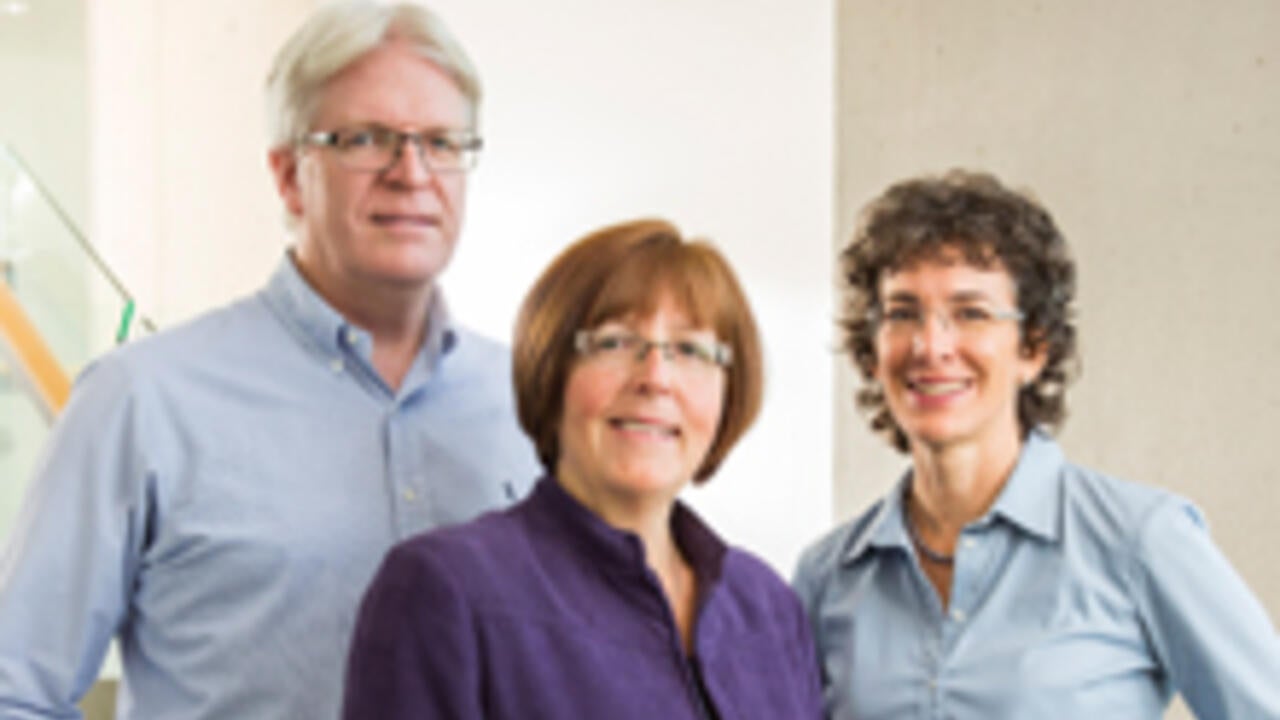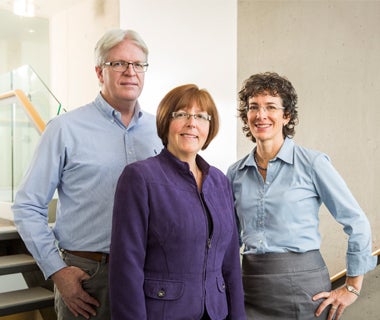
Canadian Index of Wellbeing drives change
New surveys from Waterloo-based organization are helping communities improve health services and programs

New surveys from Waterloo-based organization are helping communities improve health services and programs
By Christine Bezruki Applied Health SciencesIt’s not just a report on a shelf, says Linda McKessock, project manager for the Canadian Index of Wellbeing (CIW), a University of Waterloo-based organization aimed at helping close the gap between Canada’s rising GDP and the population’s lagging wellbeing.

Bryan Smale (left), Linda McKessock (middle) and Margo Hilbrecht (right)
For the last 15 years, the CIW has been quietly working behind the scenes to measure how Canadians are doing in eight quality of life domains ranging from education to living standards to leisure and culture. Now, as the Association of Ontario Health Centres (AOHC) celebrates Community Health and Wellbeing Week, the impact the CIW is making at the local level is taking centre stage.
Improving health
In what is the first phase of a three-year partnership with the AOHC and the Ontario Trillium Foundation, the CIW is working to integrate their framework into a new sector-wide health and wellbeing strategy.
“AOHC realizes that in order to reduce strain on the health care system, they need to shift attention to the root causes of poor health,” says Margo Hilbrecht, CIW’s associate director of research.
Using a new community health centre intake survey, the CIW is helping to identify gaps between the types of services clients need and what actually exists system-wide.
“Often, something as simple as making sure a client is referred to other agencies outside of the health sector, results in reducing the need for patient visits,” says Hilbrecht.
Many AOHC centres are already working to deliver services and programs that address the eight CIW domains— like the Centre de Santé Communautaire du Grand Sudbury. Recognizing that education is a crucial to wellbeing, the Centre established the Back to School Community Store. The store provides low-income families a place where they can buy brand new school supplies at ten per cent of the actual cost, either through a cash contribution or through volunteer work.
“Health and wellbeing is not just something you access in a medical clinic. It begins in our homes, and our schools and the communities where we live,” says Adrianna Tetley, AOHC executive director and a Faculty of Applied Health Sciences alumnus. “Access to good nutrition, housing, social supports, employment, income, and education have a much bigger impact on health and wellbeing than what medical care can provide.”
Vital signs
On home turf, results from the CIW’s community wellbeing survey are reflected in The Kitchener and Waterloo Community Foundation’s latest Vital Signs report, released October 1st. Part of a national program, Vital Signs provides participating cities with a comprehensive look at quality of life.
“The CIW community wellbeing survey is the perfect complement to Vital Signs,” says CIW director and Applied Health Sciences professor Bryan Smale. “In an increasingly diverse area like Waterloo Region, knowing more about why residents who might be disadvantaged are having difficulty accessing needed services and programs can lead to real change and improve the wellbeing of both affected individuals and the community as a whole.”

Read more
Meet five exceptional Waterloo graduate students crossing the convocation stage as Class of 2025 valedictorians

Read more
Irfhana Zakir Hussain works to strengthen Waterloo’s capacity to withstand and recover from climate-related health crises

Read more
Landmark study is a collaboration between Canadian Cancer Trials Group, WRHN and UW WELL-FIT program
The University of Waterloo acknowledges that much of our work takes place on the traditional territory of the Neutral, Anishinaabeg, and Haudenosaunee peoples. Our main campus is situated on the Haldimand Tract, the land granted to the Six Nations that includes six miles on each side of the Grand River. Our active work toward reconciliation takes place across our campuses through research, learning, teaching, and community building, and is co-ordinated within the Office of Indigenous Relations.